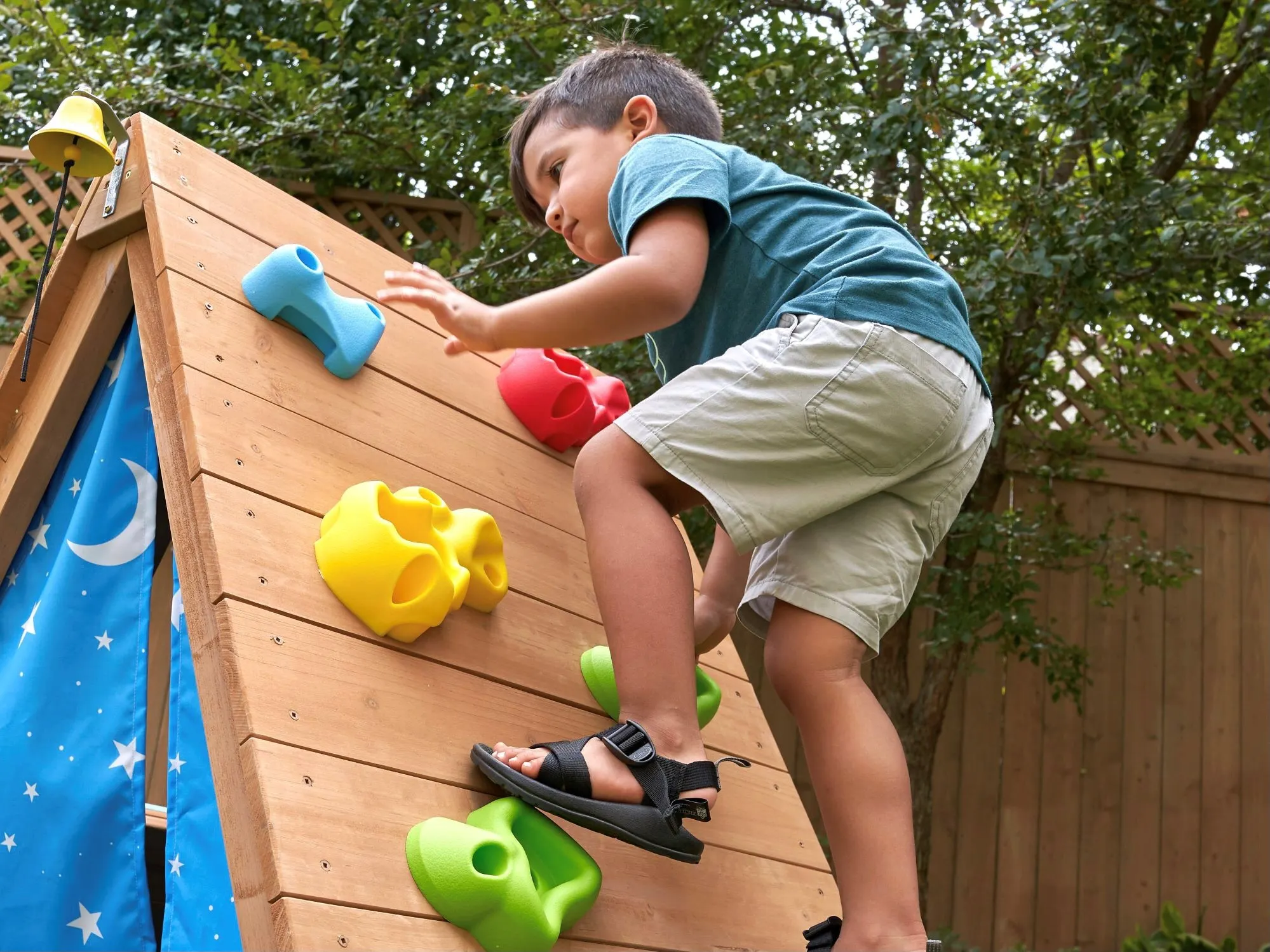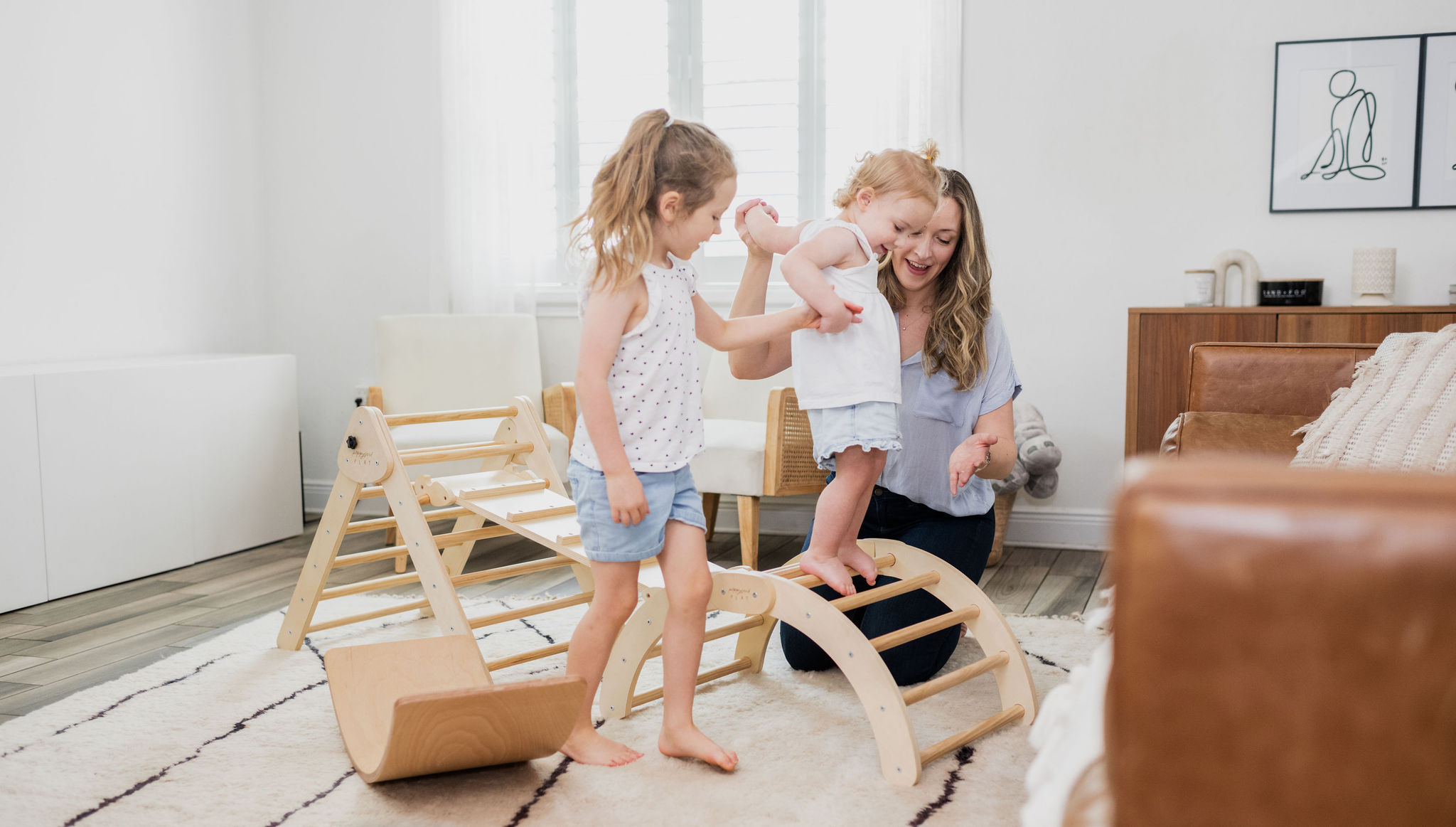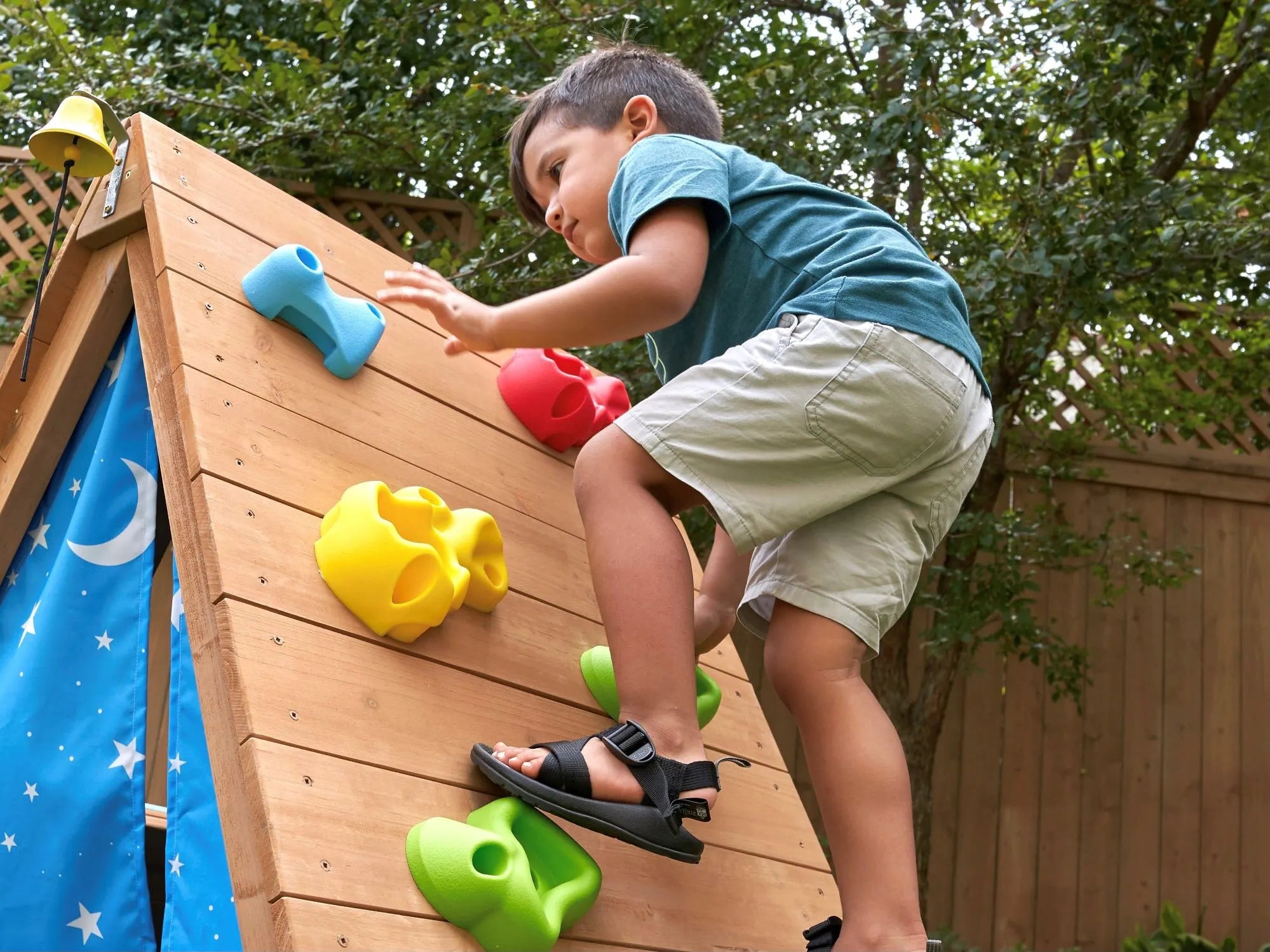Is Climbing a Gross Motor Skill? And is it Essential for Your Child's Development?
Climbing is not only a fun activity but also crucial in enhancing a child’s gross motor skills, which are vital for everyday functions such as walking, running, climbing, and playing, thereby laying a foundation for their overall development. This article delves into how climbing, as a gross motor skill, goes beyond mere physical activity to significantly boost coordination, cognitive function, and emotional resilience.
Understanding Gross Motor Skills
Beginning with the fundamentals, a child’s gross motor skills are all about using those larger muscles in the arms, legs, and torso to perform whole-body movements. Think about your kiddo rolling over, sitting, crawling, or walking. All these milestones they achieve are courtesy of their developing gross motor skills. Now, don’t confuse them with fine motor skills, which are about small, precise actions using smaller muscles. Yes, picking up a Lego piece from the floor is a fine motor skill, not a gross motor one!
These gross motor skills are not just for the physical stunts your kids love to pull. They also play a significant role in their language development. Your child’s ability to sit, walk, or balance can actually predict their expressive and receptive language skills. Amazing, isn’t it? Activities like climbing are essential to develop gross motor skills, which in turn, support a child’s ability to perform everyday functions. Additionally, it's important to recognize that gross motor difficulties can significantly impact a child's ability to perform daily functions and navigate their environment, potentially leading to challenges in school, work, and home life.
Defining Gross Motor Skills
Gross motor skills, also known as physical skills, are about moving the body in space, crucial for activities like running, jumping, and throwing. Gross motor abilities involve the coordination of skeletal muscles, bones, and nerves to perform complex movements like standing, walking, running, leaping, and even moving the neck and torso.
But these skills don’t just appear overnight. They start developing from infancy, with early movements like crawling, turning, twisting, reaching, and kicking, as well as running, jumping, and climbing movements in toddler and preschool years, all of which are crucial for a child’s development at a young age.
So, the next time you see your little one spinning around, remember, it’s not just fun, but a step towards developing their gross motor skills!
The Role of Gross Motor Skills in Child Development
Gross motor skills aren’t just for those adorable baby rolls or toddler runs. They play a vital role in language development too. Studies show a clear connection between the development of specific gross motor skills like sitting and walking and the development of receptive and expressive language skills. Yes, the better they move, the better they express!
Not just that, these skills also enable children to explore and interact, leading to significant changes in their language development and learning opportunities. Therefore, each instance of their struggle with walking, climbing stairs, or carrying items signifies their work on gross motor skills, thereby facilitating their language development.
Climbing as a Gross Motor Skill

Having acknowledged the significance of gross motor skills, it’s time to focus on a commonly underestimated skill - climbing. Yes, that irresistible urge your child has to climb everything they see is actually an important gross motor skill. It requires whole-body movements and involves large muscle groups, which we now know are crucial for developing gross motor skills.
Climbing is like a full-body workout for your little one. It helps them work on their:
-
Overall energy use
-
Planning of movements
-
Core strength development
-
Spatial and directional awareness
So, climbing basically serves as a holistic tool for promoting physical development by nurturing the essential physical abilities needed for childhood growth and improving gross motor skills, including spatial and directional awareness.
Benefits of Climbing

Climbing is not just a gross motor skill; it’s a whole lot more. It’s a physical challenge that improves balance, muscle strength, and coordination, providing upper body support. It’s like a gym session for your child!
But the benefits of climbing aren’t just physical. It also promotes cognitive development, improving sensory processing, and problem-solving skills. Imagine the mental workout your kid gets when they try to figure out the best way to climb a structure! Plus, it helps them manage different emotions like excitement and frustration, fostering emotional resilience and confidence.
Now you can picture your next trip to the playground as a lesson in motor development vs. merely a fun time.
Developing Climbing Skills
But, what’s the strategy to cultivate these climbing skills? Well, it starts with engaging with various activities and toys that promote different movements and encourage creativity, which is crucial for climbing. You can head over to the playground or even create a home obstacle course to reinforce children’s maneuverability over uneven surfaces and support the enhancement of climbing skills.
Also, remember, climbing is a gross motor skill. So, any activity that improves gross motor skills will indirectly improve climbing skills. Here are some "non-climbing" activities that can help improve climbing skills:
-
Playing catch
-
Crawling through tunnels
-
Walking on a balance beam
-
Running around the yard
-
Jumping stepping stones
All these activities are fun and contribute towards developing those much needed climbing skills.
Equipment and Toys for Enhancing Gross Motor Skills
When it comes to developing a child's gross motor skills, a variety of equipment and toys play an essential role. These tools are designed to improve balance, coordination, and strength, whether found on the playground or within the home.
Playground Equipment
Outdoor playgrounds are treasure troves for children's physical development. Slides, swings, climbing frames, monkey bars, spring riders, and see-saws challenge a child's body in numerous ways, promoting dynamic play that enhances gross motor skills. These structures encourage children to climb, swing, slide, and balance, which are all activities that support the growth of their larger muscle groups.
Indoor Climbing Toys and Home Obstacle Courses

Not to be outdone by their outdoor counterparts, indoor climbing toys and home obstacle courses offer similar benefits. They are particularly useful for times when going outside isn't an option. Indoor climbing structures, soft play equipment, and even makeshift obstacle courses using cushions and furniture can provide valuable opportunities for children to practice climbing, jumping, and balancing in a safe environment.
These indoor activities not only keep children active but also help them develop the same gross motor skills as outdoor playground equipment. They can include:
-
Indoor climbing walls
-
Foam blocks
-
Tunnels
Other Equipment for Gross Motor Development
Beyond playgrounds and indoor toys, other equipment such as trampolines, balance bikes, and sports gear such as balls and rackets also contribute significantly to the development of gross motor skills. These items encourage a range of movements and activities that require children to use their large muscle groups, thus improving their physical abilities and coordination.
The Importance of Variety
A variety of equipment and toys are important for gross motor development as they offer different challenges and require the use of different muscle groups. By engaging with a diverse range of physical activities, children can develop a well-rounded set of gross motor skills, which are crucial for their overall growth and development.
Whether it's scaling a jungle gym at the park or navigating a homemade obstacle course in the living room, the tools we provide for our children can significantly impact their physical development. By incorporating a mix of outdoor and indoor equipment and toys into their playtime, we can support and enhance their gross motor skills development.
The Connection Between Gross and Fine Motor Skills
As we emphasize gross motor skills, it's crucial to recognize their interplay with fine motor skills. The proficiency in grasping, infants' initial fine motor skill, is shaped by gross motor skills and linked to more extensive movements and muscle strength.Proficiency in gross motor skills boosts proficiency in fine motor skills as well. This connection highlights the importance of mastering both skill sets for overall development.
How Gross Motor Skills Support Fine Motor Development
Gross motor skills like balance and coordination are crucial for fine motor skill development. Hand-eye and foot-eye coordination, essential for fine motor skills, are developed through gross motor actions like throwing and catching or kicking a ball. Climbing frames and other playground equipment also challenge children’s hand-eye coordination and problem-solving skills, which are integral to fine motor development.
Activities like pulling levers and spinning blocks also play a role in building fine motor skills by improving hand-eye coordination.
Encouraging the Development of Both Skill Sets
Encouraging the development of both skill sets involves providing opportunities for children to engage in various physical activities that boosts physical skills and develop both gross and fine motor skills. Some activities that can boost a child’s gross and fine motor skills include:
-
Ball play
-
Tag
-
Balancing exercises
-
Obstacle courses
-
Music and dance
Engaging in these activities can subsequently aid the development of fine motor skills while also strengthening their gross motor skills.
Summary
So, there you have it. The seemingly simple act of climbing is a crucial gross motor skill that plays a key role in your child’s physical and cognitive development. From enhancing muscle strength and coordination to fostering problem-solving skills and emotional resilience, climbing is an all-round developmental activity. So, the next time your child clamors to climb that jungle gym, let them. They are not just playing, but learning and growing.
Frequently Asked Questions
Is climbing a fine or gross motor skill?
Climbing is a gross motor skill because it involves using large muscle groups like arms and legs to accomplish the task.
What are gross motor skills?
Gross motor skills are basically the fancy moves your bigger muscles pull off to get you around, like walking, jumping, and throwing yourself on the couch dramatically after a long day. It's all about the big muscle action!
Why is climbing considered a gross motor skill?
Climbing is considered a gross motor skill because it involves using major muscle groups and whole-body movements. So, next time you climb a tree, just remember you're flexing those big muscles!
How can playground equipment help in developing gross motor skills?
Playground equipment like slides, swings, and monkey bars help kids develop their balance, coordination, and strength, leading to improved gross motor skills. So, let's encourage more monkeying around at the playground!




